Featured Comment:
“I made this today with minced chicken breast and it came out great!! The sauce is so tasty and the perilla leaves add a nice depth of flavor. I’m gonna be making a bunch of your recipes today! Thank you 🙂”
– Ming
What is Tsukune (Japanese Chicken Meatballs)?
Tsukune is a Japanese-style meatball made by adding starch or another binder to ground chicken, pork, fish, or other meat, shaping it into round dumplings or oblongs, often served on skewers. It does not have to be chicken, but from a Japanese perspective, the first thing that comes to my mind when I think of “tsukune” is chicken tsukune.
Yakitori (焼き鳥) is meat cut into bite-sized pieces, skewered, and grilled over an open flame. An interesting thing about yakitori is that even though the name “yakitori” literally means “grilled chicken,” it doesn’t have to be chicken (arguably), and many yakitori establishments offer pork and offal.
According to the Japan Yakitori Association, the definition of yakitori goes:
- Made from chicken, pork, beef, or other livestock (including wild game) meat or offal.
- Bite-size pieces served on a skewer.
- Seasoned with salt or sauce and grilled.
As those who have been to yakitori restaurants in Japan might know, tsukune-gushi (skewered tsukune) is among the most popular yakitori available. In that context, it’s skewered and grilled over a charcoal flame.
However, you don’t have to grill tsukune when you make it at home! In this recipe, I will explain how to cook tsukune in a frying pan. Of course, you can still use this recipe for your next BBQ.
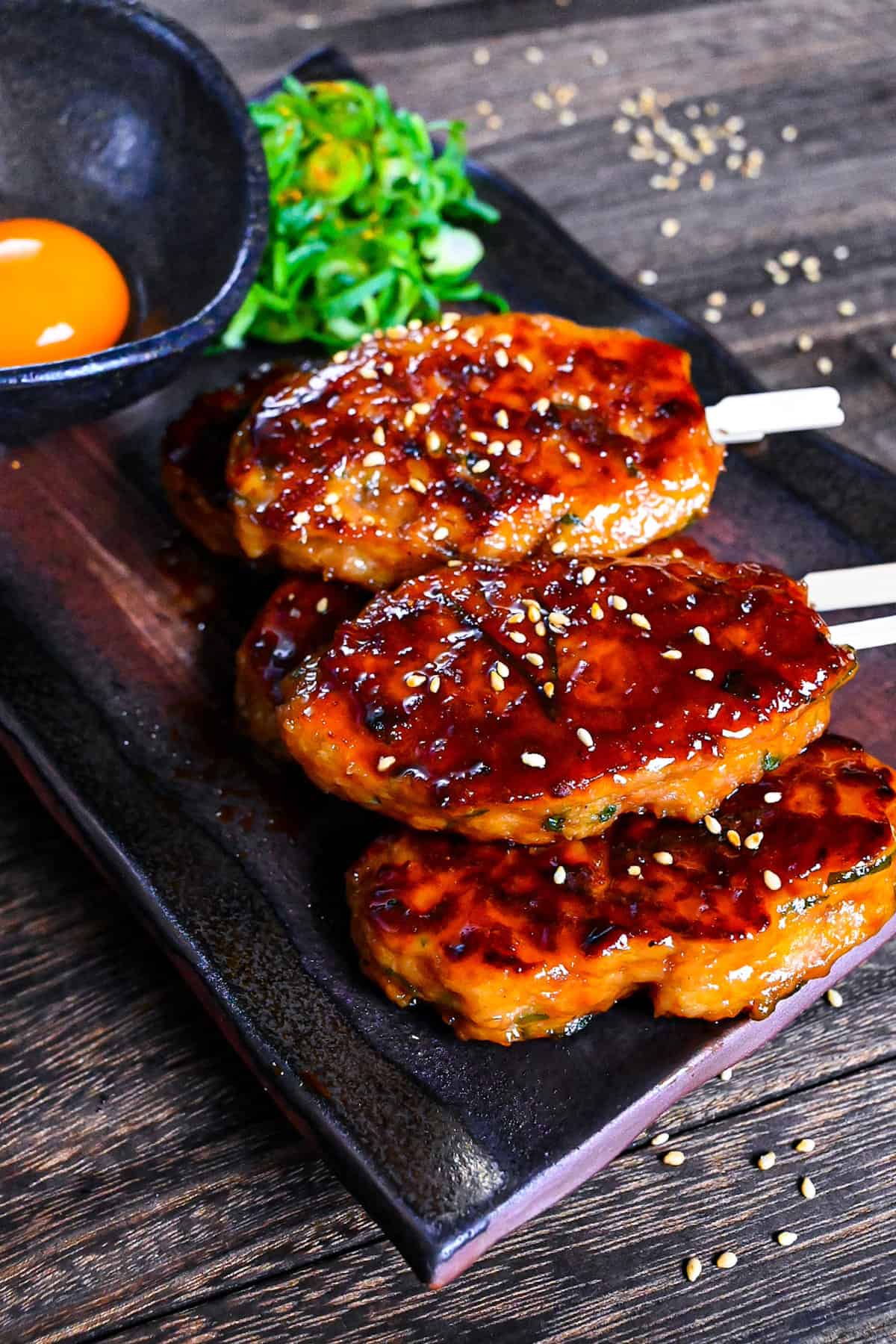
Ingredients & Substitution Ideas
- Yellow Onion: Grated onions are preferred for blending seamlessly into the tsukune mixture. This method releases moisture, which can be squeezed out, resulting in a smoother mixture without excess liquid.
- Ground Chicken: Both thigh and breast mince are available in Japan, with thigh mince being fattier and juicier and breast mince being leaner. I prefer thigh meat, but breast meat can also be used, especially since the glaze helps to counteract any dryness.
- Perilla Leaves (Ooba/Shiso): Known for their strong, refreshing flavor, they’re related to the mint family. They can be omitted or substituted if unavailable with alternatives like green onion, peppermint, or basil.
- Japanese Mayonnaise: Adding mayonnaise improves the tsukune’s texture, making it soft and fluffy.
- Ginger: Often used in Japanese cooking to neutralize strong meat or fish flavors. Its enzyme content also tenderizes meat.
- Awase Miso Paste: A mixed miso paste adds flavor and umami to the tsukune.
- Chinese-Style Chicken Bouillon Powder: This is to enhance the overall flavor.
- Potato Starch: Cornstarch or tapioca starch can also be used as substitutes.
- Pasteurized Egg Yolk: An optional ingredient for dipping, adding a rich flavor to the dish.
- Sauce Ingredients: A blend of soy sauce, mirin, sugar, and red wine creates a flavorful glaze for the tsukune.
Here are the alternatives for this particular recipe:
- Chicken breast mince (instead of chicken thigh mince)
- Turkey mince (instead of chicken mince)
- Chopped spring onion (instead of ooba)
- Chopped mint or basil (instead of ooba)
- Other types of starch such as cornstarch and tapioca starch (instead of potato starch)
- Shaping in balls (instead of ovals)
As for the addtions/customization, please refer to the list below:
- Cheese (add a couple of tablespoons or so in the mix)
- Chicken cartilage (for added texture)
- Finely diced lotus root (for added texture)
- Finely diced mushroom
- Tiny amount of silken tofu (for extra soft texture)
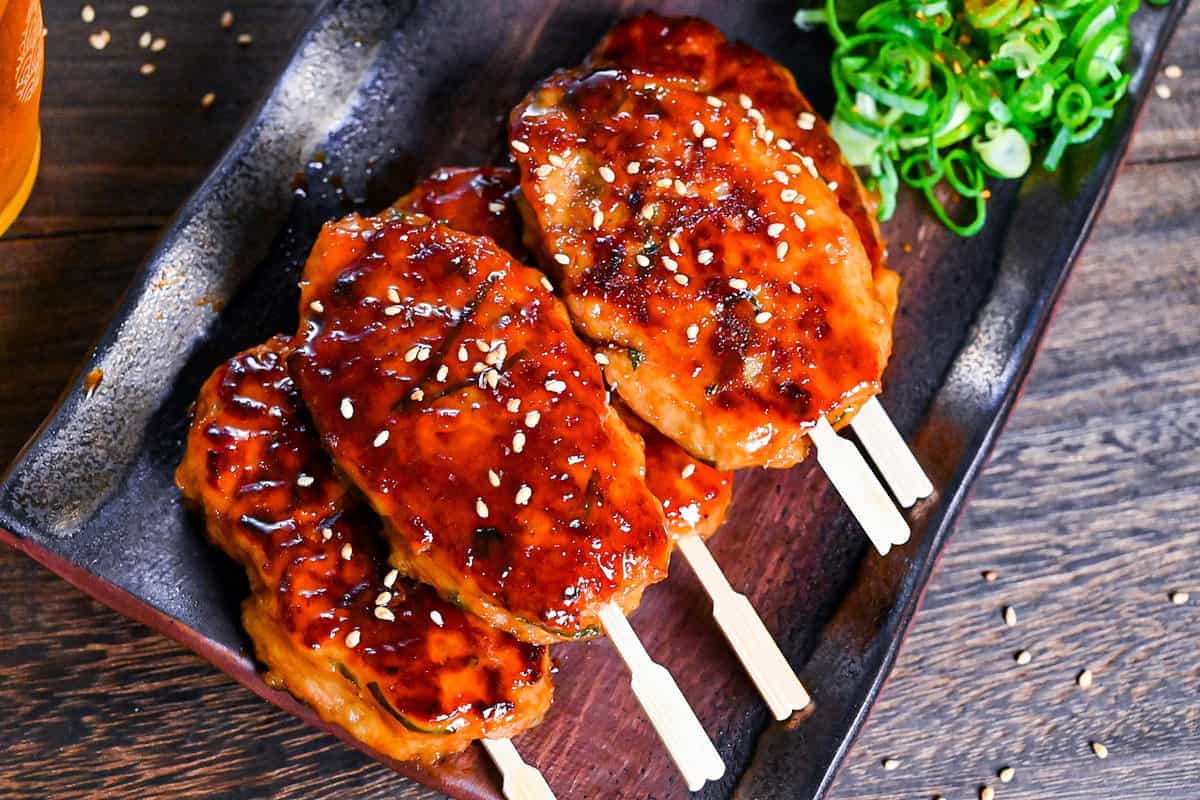
Visual Walkthrough & Tips
Here are my step-by-step instructions for how to make Chicken Tsukune at home. For ingredient quantities and simplified instructions, scroll down for the Printable Recipe Card below.
If you prefer to watch the process in action, check out my YouTube video of this recipe for a complete visual walkthrough!
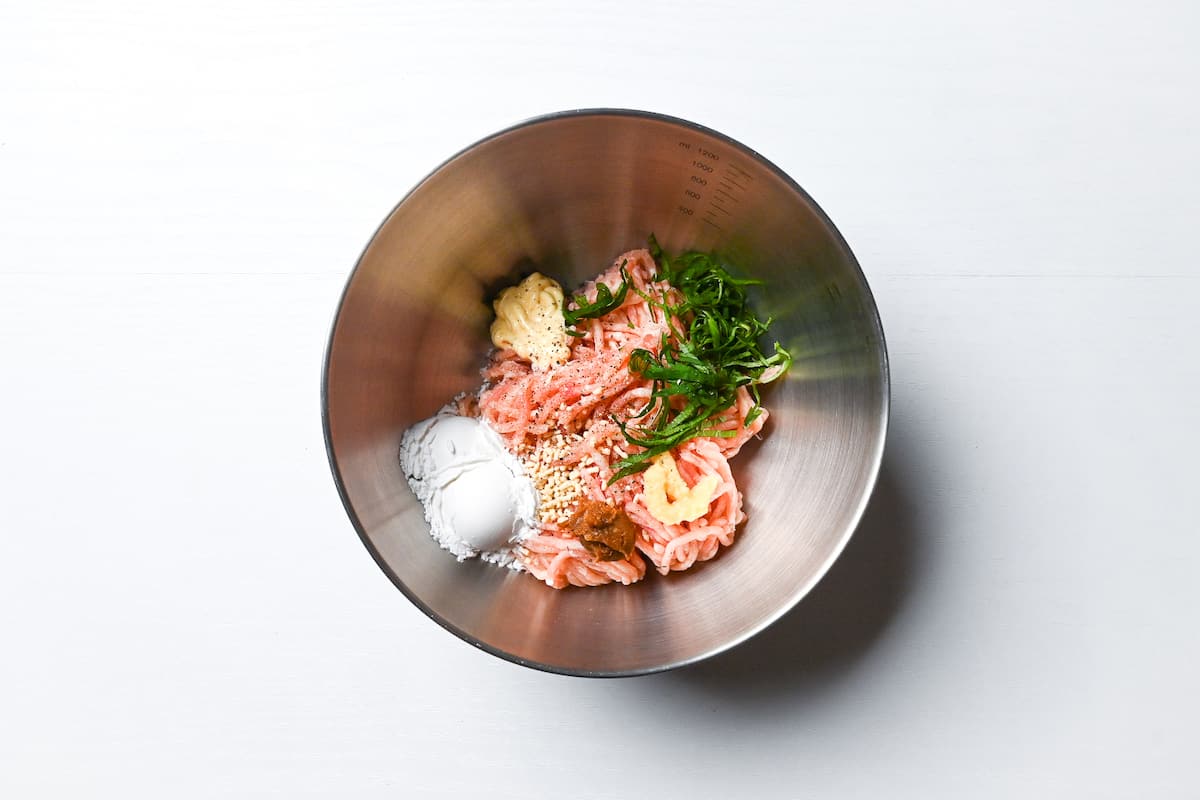
Who doesn’t love a recipe that you can mix all together in one bowl? Simply throw the grated onion, chicken mince, sliced perilla leaves, mayonnaise, grated ginger, miso paste, chicken stock powder, potato starch, and black pepper into a large bowl and mix with a spatula.
Before adding the grated onion to the bowl, make sure to drain it thoroughly as grating the onion will release a lot of water, which can make the meat mixture soggy.
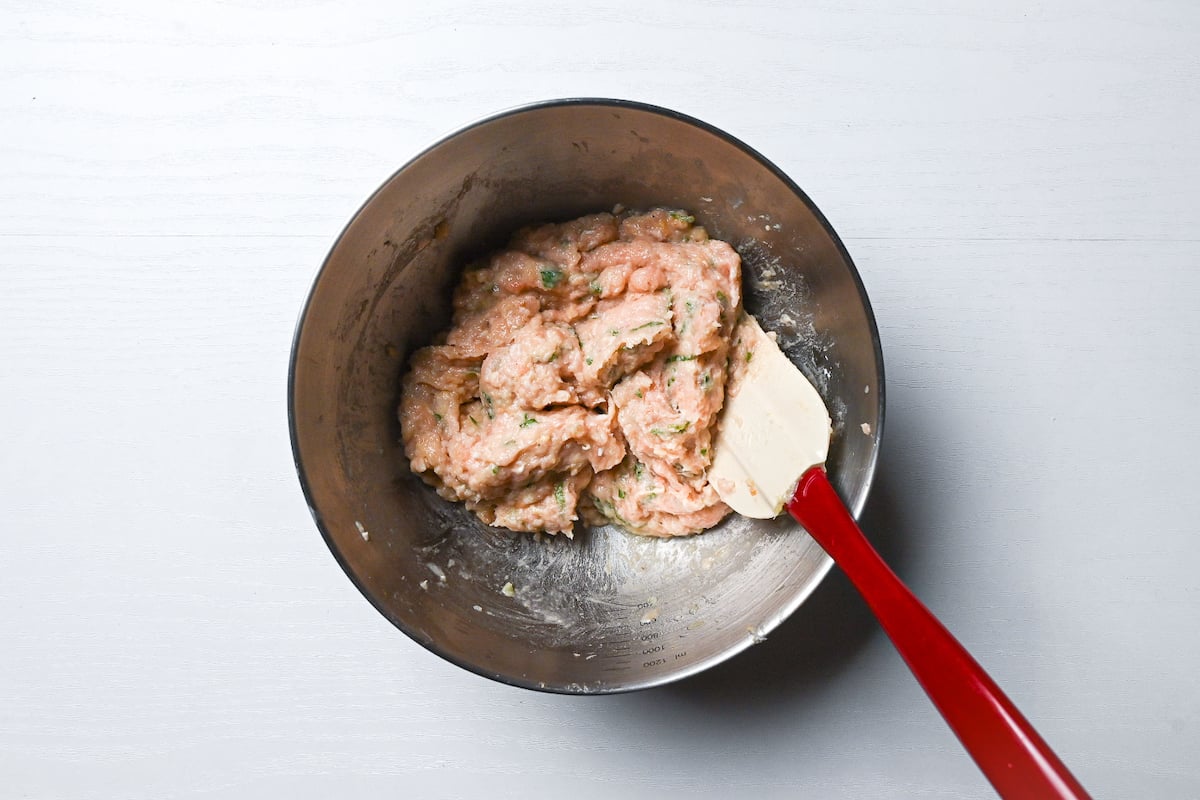
I use a spatula rather than my hands for this because I want to keep the mixture cool before I shape it later (bare hands tend to warm up the ingredients).
Once the mixture is well mixed, it’s time to shape them.

The most common ways to shape tsukune is either into balls or oblongs (like pictured above) and then serve on bamboo skewers. If you make balls, divide the mixture into 12-15 balls, which will be enough for 4-5 skewers.
Alternatively, you can divide the mixture into 5 and make oblongs like I did! (It’s quicker!)
I have 2 methods for shaping. One is to oil my palms, shape them by hand, and then place them straight into a heated pan. The other method is cutting strips of baking paper, placing each portion on top, and then shaping it using the edge of a spoon.
Using the baking parchment method, you can transfer each tsukune meatball to the heated pan with the paper side facing up and then peel it away without misshaping it.
While yakitori restaurants and stands would usually cook tsukune over a charcoal grill, this is a home recipe so I opted for a simple frying pan instead.
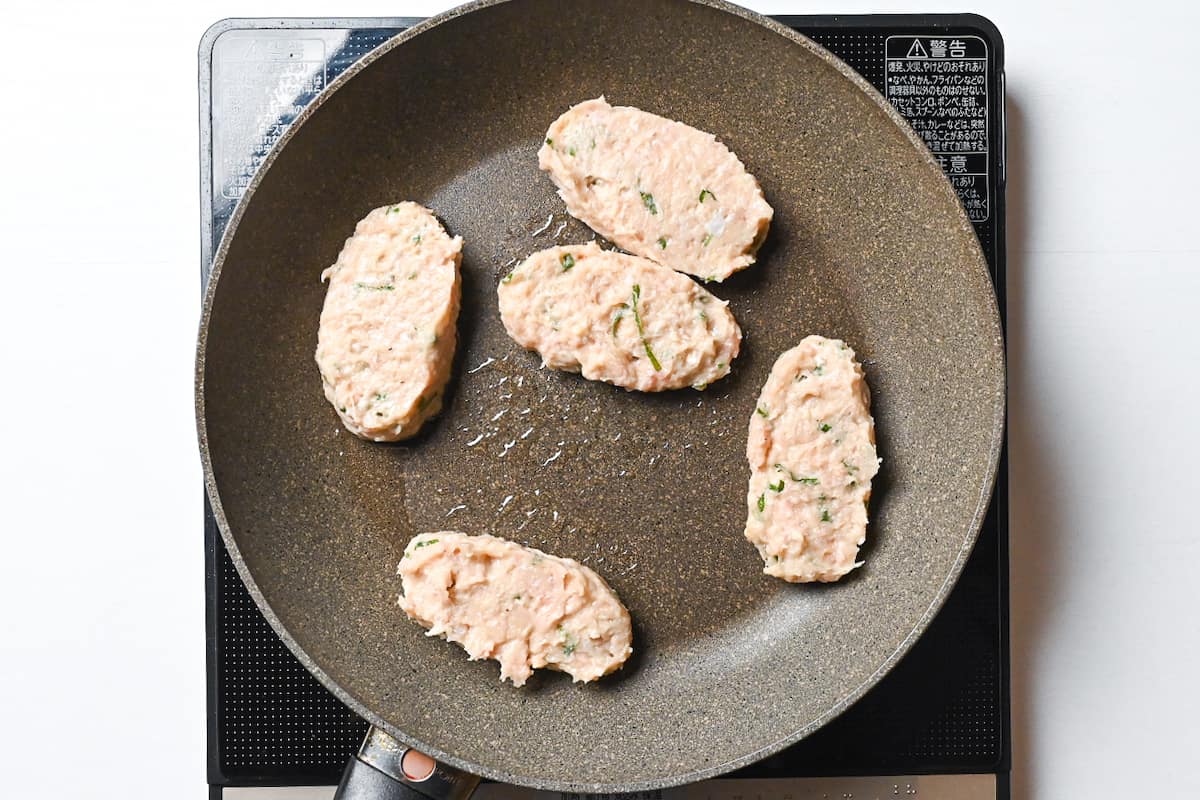
Place the tsukune in the pan and brown them on both sides, frying until they’re fully cooked all the way through. This generally takes about 2-3 minutes on each side but can vary slightly depending on the thickness of the tsukune and the power of your stove.

Keep in mind that if you’re making the ball-style tsukune, you will have to keep rotating them to ensure they’re browned evenly all over.
While the tsukune is cooking, I combine soy sauce, sugar, mirin, and red wine in a small bowl. Give it a mix and then it’s ready to add to the pan.
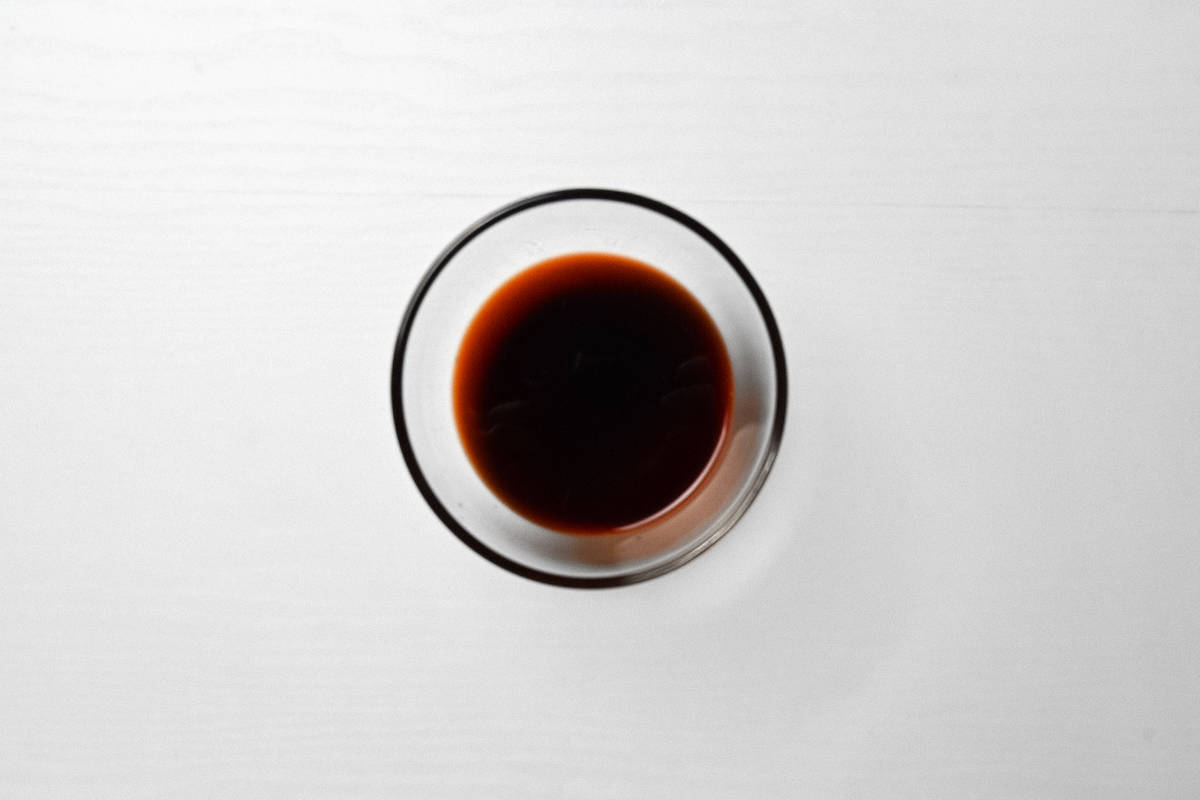
Once the tsukune are cooked all the way through, turn off the heat and add the sauce!
Because this sauce is small and contains sugar, it can thicken and burn very quickly. To prevent this, turn off the heat before adding the sauce. The pan will still be hot, but the heat won’t be so direct, and the sauce will thicken in the residual heat.
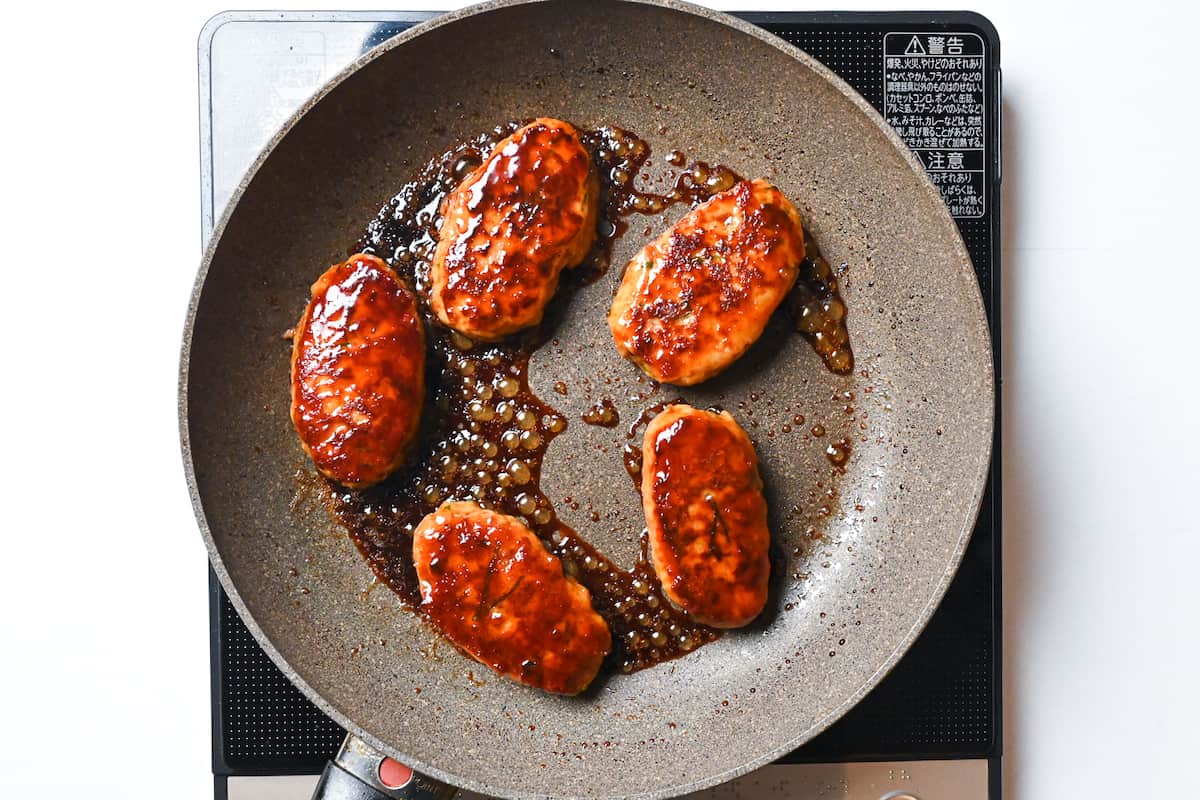
Be sure to move the tsukune around the pan and coat the sauce over both sides evenly.
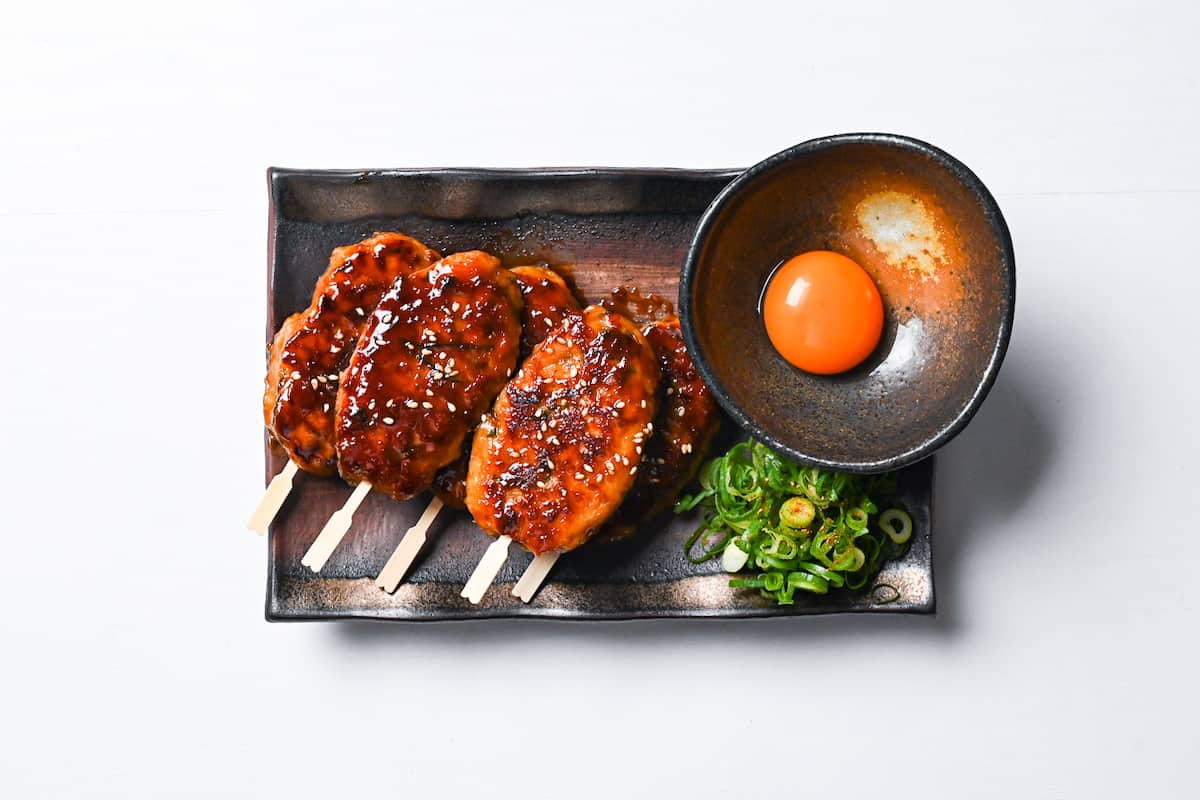
The final step is to put them on the skewers. This is optional but makes for a better presentation. (These skewers on Amazon work great and come in various sizes! I like 3.5″ or 4″ for tsukune.)
You can either let them cool for a few minutes before pushing them onto the skewers by hand (be careful not to burn yourself!) or hold them with tongs or a fork and push them in. If the sauce comes off, just hold them by the skewer and re-coat with any leftover sauce in the pan!
Lastly, garnish with sesame seeds and spring onion, and enjoy your tsukune in true Japanese style by dipping them in a raw egg yolk before eating!
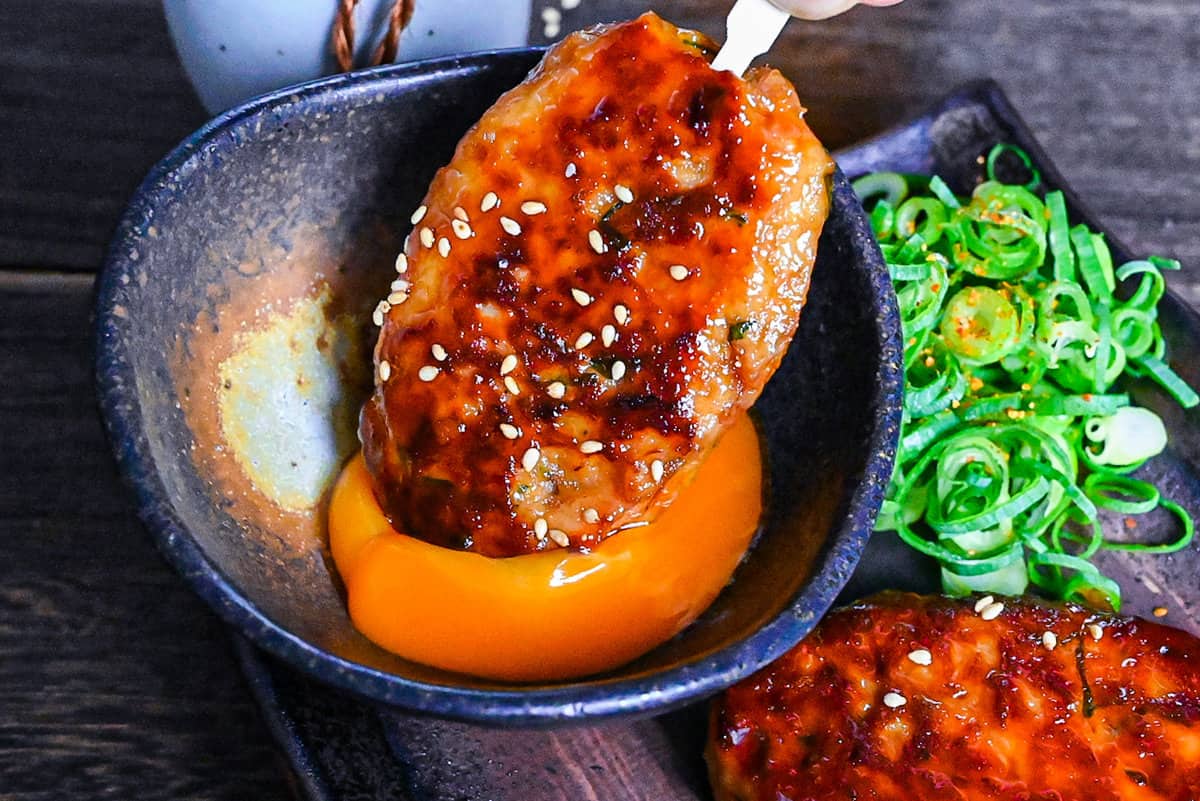
FAQ
Some restaurants might advertise their tsukune as “jidori tsukune” and you might wonder how it’s different. Jidori is a generic term for domestically raised chickens with a blood percentage of at least 50% of indigenous origin, as listed in the Japanese Agricultural Standard (JAS).
In Japan, brands like Nagoya Cochin and Hinai Jidori are the highest-grade chicken meats. Compared to ordinary chickens, these chickens are raised for a longer period of time, so the differences in meat quality, aroma, taste, etc., between brands are more obvious.
In conclusion, jidori tsukune is a tsukune that is made with these kinds of high-brand Japanese chickens.
In short, you can! As I explained earlier, tsukune is not necessarily made with chicken. You can use pork mince or beef mince. However, this recipe is optimized for chicken tsukune, so you might have to tweak the seasonings and cooking times a bit when you make it with pork or beef.
If you use alternative meat for this recipe, you can use turkey mince for a closer, leaner alternative.
You might have heard of other Japanese meatballs called “tsumire”; do you know the differences? They both are, in fact, “Japanese meatballs”; however, the usage and process are slightly different.
The word tsumire is a contracted form of the verb “tsumi ireru, ” meaning to pick and insert. “Tsumire” is a cooking method in which the mixture, which has not yet been shaped, is scooped into smaller pieces using a spoon or spatula and dropped into a hot pot to cook in the broth.
On the other hand, the word “tsukune” is derived from “tsukuneru,” meaning to knead and roll into a ball. With this in mind, “tsukune” is made by adding seasonings, a binding agent like starch or egg to the ingredients, and then kneading and shaping the dough by hand.
So, in conclusion, tsumire and tsukune are both types of meatballs but are shaped and cooked differently. I make tsumire-style meatballs in my chanko nabe recipe if you want to check it out!
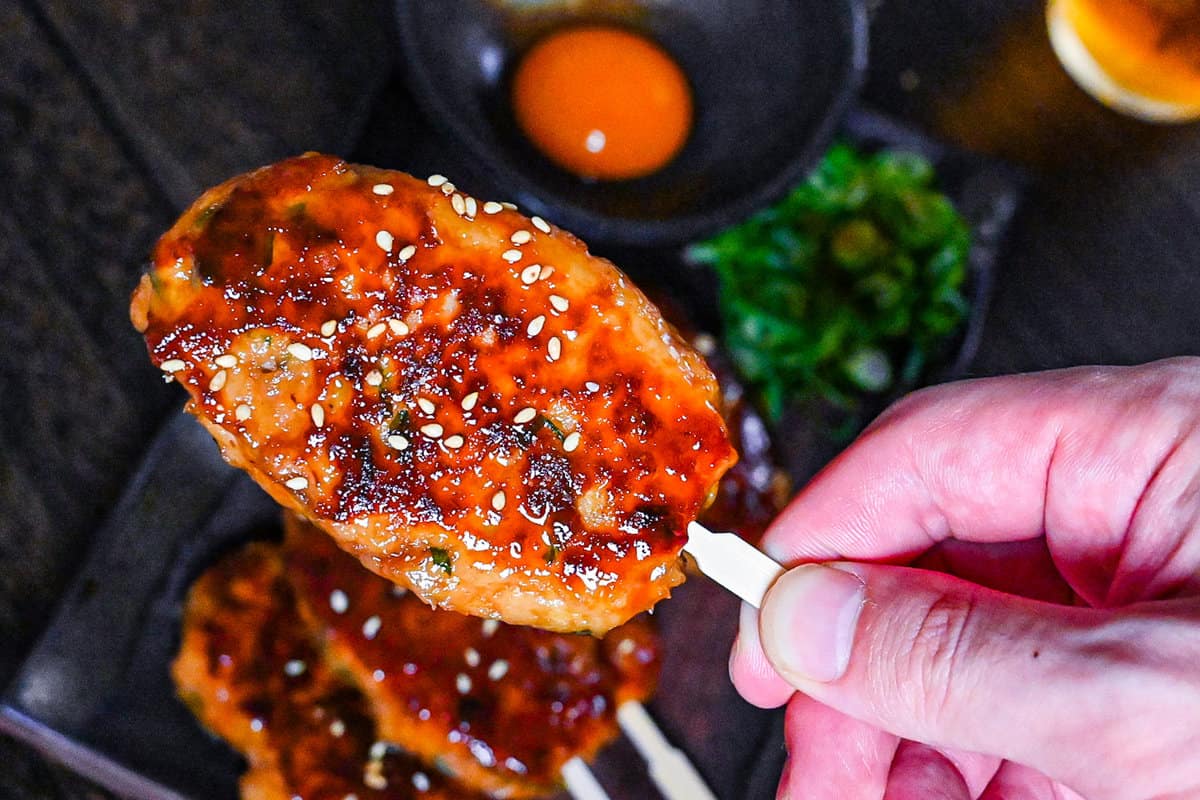
I hope you enjoy this Chicken Tsukune recipe! If you try it out, I’d really appreciate it if you could spare a moment to let me know what you thought by giving a review and star rating in the comments below. It’s also helpful to share any adjustments you made to the recipe with our other readers. Thank you!
More Japanese Chicken Recipes
- Crispy Japanese Teriyaki Chicken
- Authentic Chicken Karaage (Crispy Japanese Fried Chicken)
- Chicken Soboro Onigiri (Japanese Ground Chicken Rice Ball)
- Chicken Katsu (with homemade sauce)
Want more inspiration? Explore my Chicken Roundup Post for a carefully selected collection of tasty chicken recipe ideas to spark your next meal!
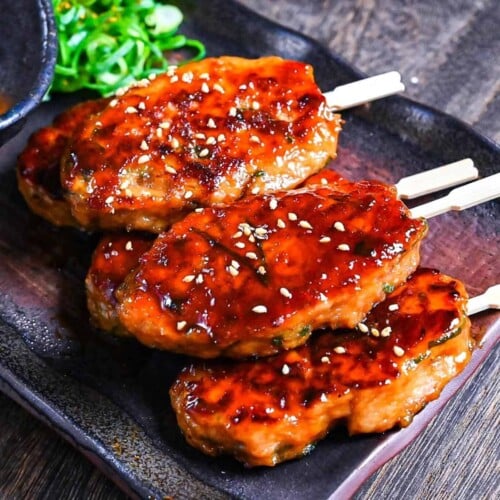
Chicken Tsukune (Japanese Glazed Meatballs)
Ingredients
- ¼ onion grated and squeezed to remove water
- 250 g ground chicken breast or thigh, either works
- 5 perilla leaves (shiso) thinly sliced
- 1 tbsp Japanese mayonnaise
- 1 tsp ginger root grated or paste
- ½ tsp yellow miso paste (awase)
- 1 tsp Chinese-style chicken bouillon powder
- 2 tbsp potato starch (katakuriko)
- 1 pinch ground black pepper
- 1 tsp cooking oil plus extra oiling hands
- 5 bamboo skewers optional
- 1 pasteurized egg yolk optional, for dipping
Sauce
- 1 ½ tbsp Japanese soy sauce (koikuchi shoyu)
- 1 ½ tbsp mirin
- 1 tbsp sugar
- 1 tsp red wine
My recommended brands of ingredients and seasonings can be found in my Japanese pantry guide.
Can’t find certain Japanese ingredients? See my substitution guide here.
Instructions
- Add ¼ onion, 250 g ground chicken, 5 perilla leaves (shiso), 1 tbsp Japanese mayonnaise, 1 tsp ginger root, ½ tsp yellow miso paste (awase), 1 tsp Chinese-style chicken bouillon powder, 2 tbsp potato starch (katakuriko) and 1 pinch ground black pepper to a large mixing bowl.

- Mix with a silicone spatula until the ingredients are evenly distributed throughout and the mixture has combined and reached a sticky consistency.

- Divide into 5 equal pieces (for balls, divide into 12-15 pieces to make 4-5 skewers with 3 meatballs on each). Grease your hands with oil and shape into oblongs or balls. (If you don’t want to get your hands dirty, transfer each piece to a piece of baking parchment and shape using a spoon.)

- Heat pan on medium and drizzle 1 tsp cooking oil. Once hot, add the tsukune to the pan and fry until crispy underneath.

- Flip and repeat on the other side.

- While the tsukune are frying, mix 1 ½ tbsp Japanese soy sauce (koikuchi shoyu), 1 ½ tbsp mirin, 1 tsp red wine and 1 tbsp sugar in small bowl.

- Once both sides are crispy and the meat is cooked through, add the sauce to the pan and turn off the heat, the sauce will thicken in the residual heat. Move the tsukune around the pan and make sure they’re evenly coated all over.

- Push onto skewers, sprinkle with sesame seeds and spring onion. Optional: serve with 1 pasteurized egg yolk for dipping.

- Enjoy!

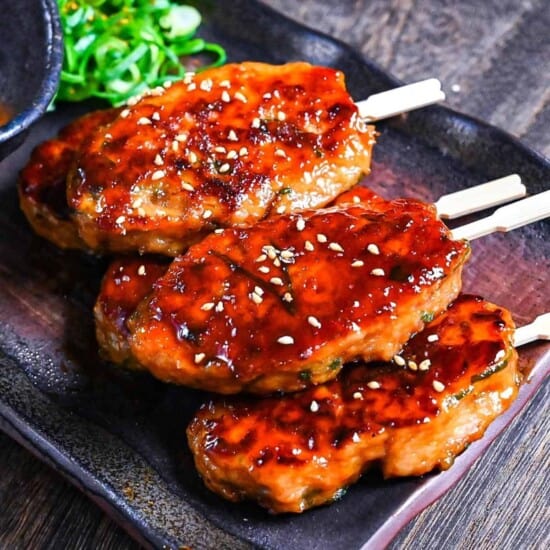








I made this today with minced chicken breast and it came out great!! The sauce is so tasty and the perilla leaves add a nice depth of flavor. I’m gonna be making a bunch of your recipes today! Thank you 🙂
Thank you so much for trying so many of my recipes and taking the time to give feedback, I really appreciate it! Let me know what you make next and if you have any questions, you can contact us anytime! Thanks again 🙂
I have recently just returned from a trip to Japan, and fell in love with the cuisine (not only because it’s delicious, but it helped heal my gut issues!) so I’ve been on a mission to incorporate Japanese cuisine into my life.
This recipe is SO TASTY! Everyone loved it, even my picky son. This will be on regular rotation in my house now! Thank you for the amazing recipe!
Hi Akiko,
Thank you for sharing your experience and photo! I’m so glad to hear that you and your family enjoyed the recipe.
I’m excited for your Japanese cooking journey! 🙂
Yuto